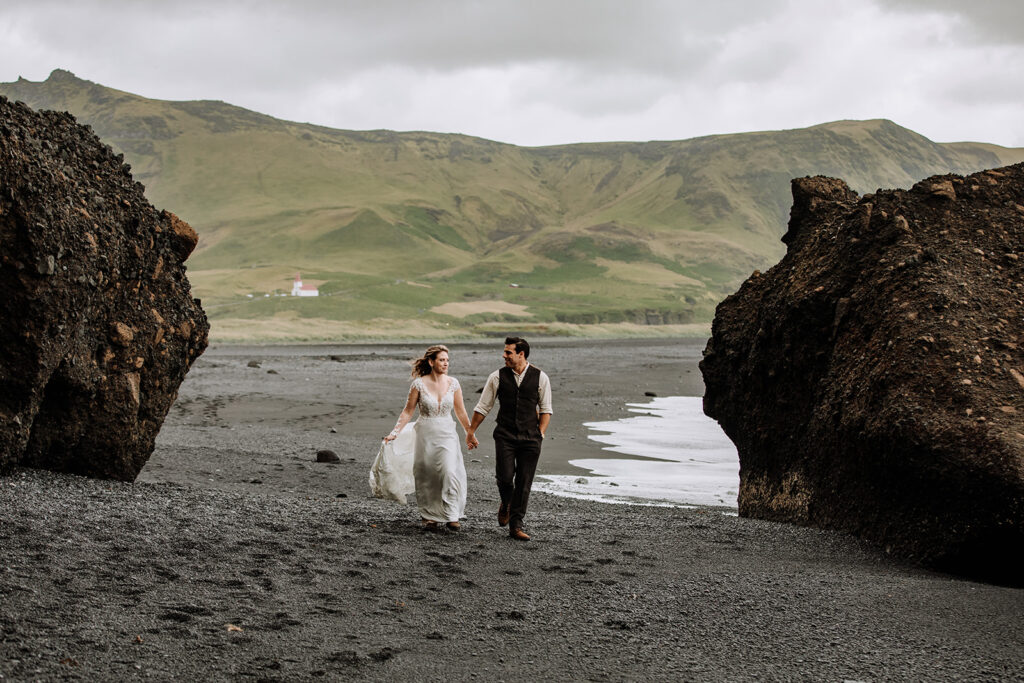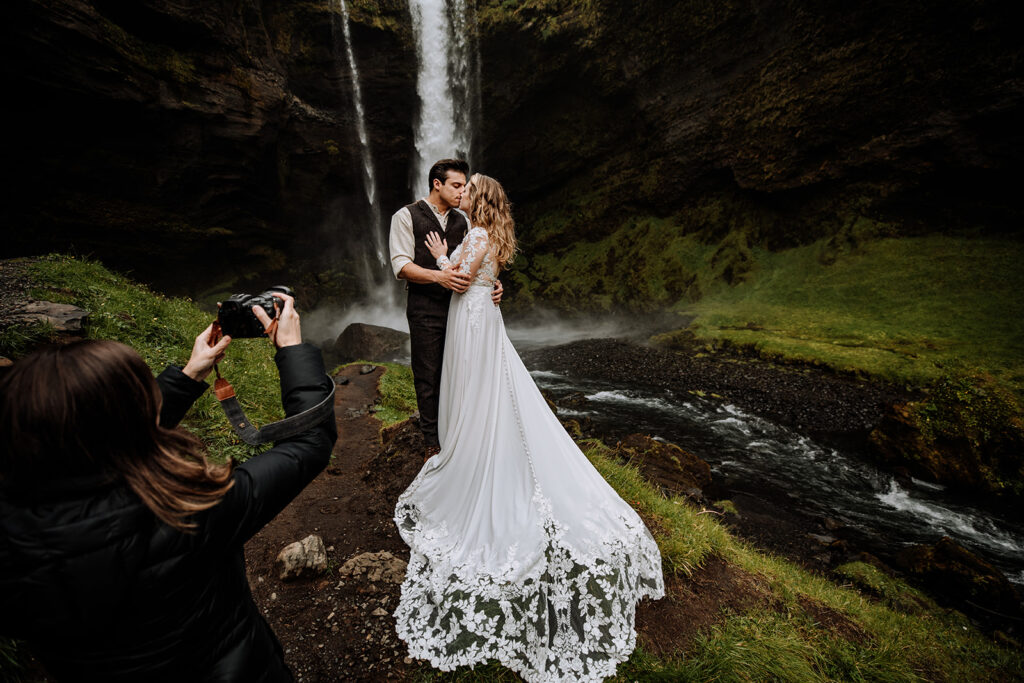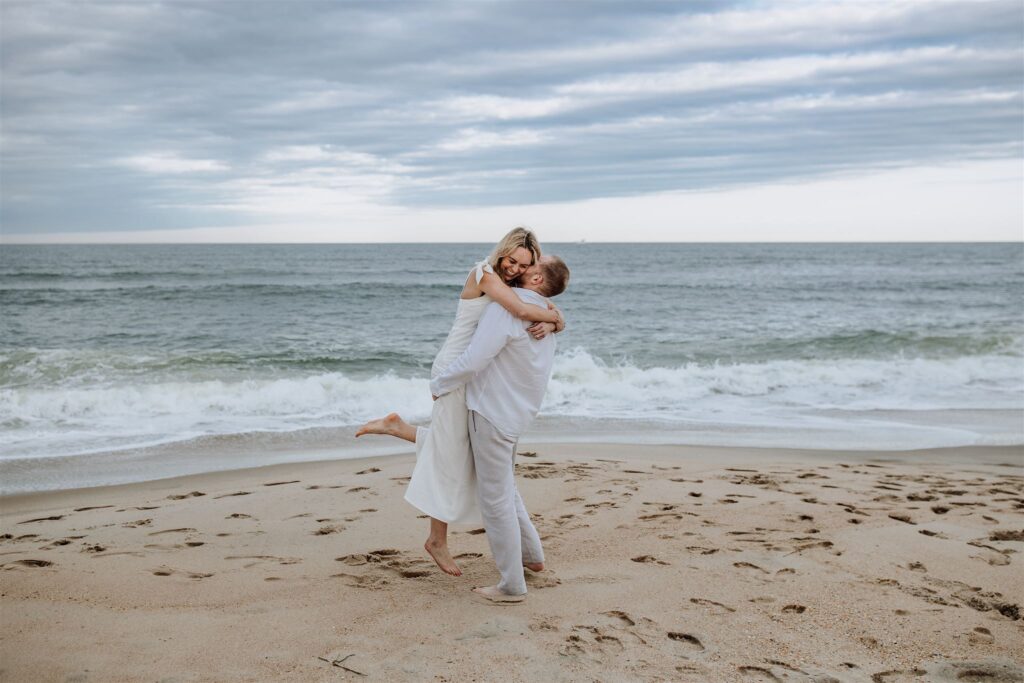
7 Ways to Set Travel Fees for Wedding Photographers (SIMPLE GUIDE!)
As experienced wedding photographers, we’ve explored many different methods to charging our clients for our travel. Unlike many photography niches, being a wedding photographer means you will be traveling a lot for your jobs and in order to run your business effectively, you’re going to want to make sure you’re charging enough to cover your costs and make it worth your while.
Some photographers opt to only take on work close to home – which might impact how they approach travel costs.
Others may take on a larger radius from home, but just stick to their car – so we need to make sure we’re covering costs of the car and gas.
Some photographers also decide to target destination wedding and adventure elopements, which may involve really extensive travel opportunities like hopping on a flight, staying at a hotel, and more.
We have actually done weddings in all of these circumstances – ranging from close to home weddings, weddings in neighboring states requiring a long drive, and weddings domestically and abroad in different countries!
In this post, we’re going to talk about one of the most significant questions wedding photographers have when setting up their pricing – how do wedding photographers charge for travel?

Wedding Photographer Travel Fees Made Easy – 7 Proven Methods
Method #1 – Just don’t charge for travel*
It could be argued that it is not an outright requirement that wedding photographers charge for travel.
There are plenty of circumstances we could think of that a photographer would opt to not charge travel fees such as…
- They are new and will take on a wedding gig, even if it means covering their own travel expenses
- They want to expand their portfolio to a new venue or region, and want to entice clients by waiving travel fees
In general, this type of reasoning is going to be used by inexperienced or new wedding photographers.
Going beyond this, there are a few valid reasons for not charging travel fees outright.
In the United States (and many other countries), businesses that involve travel can log their mileage and receive a tax deduction using an app like Quickbooks or MileIQ. In recent years, we’ve seen an average tax deduction of around $7,000 due to the amount of traveling we do.
Alternatively, you can also log receipts from all the times you fill up gas or have car appointments (repairs and inspections) and receive a tax deduction that way. The first method is the easiest for sure.
Other travel, such as airfaire, hotels, etc. for destination weddings and elopements can also be deducted from your taxes, saving you money.
To learn more, read our article about the 23 Best Tax Deductible Expenses for Photographers.
In addition, in some jurisdictions charging a travel fee may be illegal or otherwise regulated. In circumstances where this does exist, it typically applies to a separately billed travel fee invoice, but would not apply to simply increased costs for base services.
Method #2 – Charge an hourly or mile-based rate for travel
One of the most common ways wedding photographers set travel fees is to charge by the mile or per hour. Generally, this will apply to travel done by car.
Steps to charging per hour:
- Determine how much your hourly, non-shooting rate is
- Determine how long you will be driving (both ways!)
- Multiply your hourly rate x your estimated drive time
Steps to charging per mile:
- Determine how much your rate per mile will be
- Determine how long you will be in miles (both ways!)
- Multiply your mileage rate x your estimated drive distance
Many traveling service businesses will refer to the current IRS tax deductible mileage rate for setting their rate. In 2022, this rate was 58.5 cents per mile and typically increases a little bit each year.
The best way to determine how much time or miles you will be spending driving is to plug in your travel destination(s) into an app such as Google Maps, Waze, etc.

Method #3 – Provide free travel within a limited radius, charge after
As wedding photographers and service providers, we are expected to travel for our work – it just comes with the territory. As a result, it can feel wrong to charge travel fees (especially for gigs nearby), and in some circumstances a travel fee can also be off putting to potential clients – resulting in a loss of business.
One solution to this is to offer travel for free within a limited radius, and only charge a travel fee for events beyond your radius.
It’s up to you to decide what this radius should look like.
Examples we have seen in the wedding industry:
- Free travel up to 3 hours
- Free travel up to 30 miles
Many years ago, when we used this strategy, we would offer weddings and sessions for free within 30 miles of our town. This would be roughly 30-45 minutes of driving. To us, it was worth getting bookings in this region without the extra headache of charging for travel. We were comfortable taking on opportunities in this proximity without charging extra.
Method #4 – Price out the cost of all travel requirements (gas for car, airfaire, hotel, etc.) and invoice client
While methods #2 and #3 can work for wedding photographers traveling by car, destination wedding photographers have different travel costs to account for.
One common solution is to simply price out all your required travel spending, then invoice your clients for the costs you are incurring.
For example, if you are based in Pennsylvania (hey! That’s where we are too!) and have the opportunity to photograph a destination wedding in Iceland…you’ll might have a cost breakdown like this:
- Airfaire: $500
- AirBNB Rental: $400
- Car Rental: $300
- Meals: $100
- Airport Parking: $50
- TOTAL: $1,350
Once you price everything out, you can take this total to your client and bill them for the costs.
Some destination photographers might even add some extra, to build in some extra profit to make it worth their while.
While this solution makes sense on paper, and can work for some photographers, we recommend against it.
This is based on our personal experience, as well as understanding that from a sales perspective – when a client sees this big price tag for your travel, they’ll look for opportunities to reduce costs.
For example – you price out airfaire for $500 because you see some flights with an airline you already like at that rate. Your client goes on an flight booking website and finds another flight for $300 – it just happens to be with a worse airline or with departure/arrival times that are rough. Still – you may have to negotiate with the client as to why they should spend that extra $200 for you to have a better travel experience.
There are other holes we could poke into this method of pricing travel as a wedding photographer, but for this post we’ll leave it here and move on to the next method.
Method #5 – Increase your package prices to cover travel, don’t charge a “travel fee”
The last way to “charge” for your travel is to simply build it into the cost of your wedding photography service packages.
This is a strategy we recommend when you create your own wedding packages and pricing.
Let’s look at an example from one of our wedding photography businesses to see how we increased our prices, covered travel expenses, and made a better client experience all in one go:
When we began our journey in wedding photography, we would charge clients travel fees in addition to our regular package pricing. These would be fees that kick in after 30 miles of driving. For many of our clients, this resulted in fees ranging between $20 – $100 dollars because we’d find ourselves driving between 60-100 miles.
During the following year, we looked back and found that from travel fees alone – we made around an extra $2,000 – not a ton of money, but nothing to regret. Still, we also remembered many conversations with clients talking about these travel fees – what they cover, why they are priced the way they are, and similar.
We decided to shift our pricing model so our packages covered travel costs. We raised all of our packages by $200 (at the time). When we booked 30 weddings, we’d make $6,000 more to cover the travel.
This strategy made it easier for prospective clients to want to work with us, and we made more money. In fact, when we looked back on that year of earnings, we actually had less out-of-pocket travel expenses and walked away with a large profit on that $6,000 earnings.
This method has since been a staple in our business!
Method #6 – Raise your prices and charge a travel fee over a certain radius
Our current travel pricing model mixes a few different strategies we’ve covered here.
First, we have raised our package pricing to cover travel. We don’t typically charge clients a fee.
The exception is for work opportunities that are significantly out of our driving radius. Where we live – this includes travel over 3 hours away or into New York City (which is a nightmare in itself even though it’s pretty close by).
When we do charge a fee, it’s a flate rate. We don’t calculate mileage or hours, but give people a flat rate that covers our expenses and time.
We also provide our clients with options that include locations that do not require travel fees. This is particularly common with engagement sessions where there may be flexibility in the location.
Method #7 – Create multiple pricing sheets for different areas
Building on method #5, if you serve multiple regions with your wedding photography business – we recommend building out different price sheets to reflect the associated travel costs for those area.
For example – we have different price points depending on where our couple’s wedding venue is located. Local clients have one price sheet, clients in our major metro areas (Philadelphia and NYC) have different price points, and domestic/international clients requiring airfaire have a different one, too!
To do this really effectively, it’s valuable to do market research – something we cover extensively in our Branding for Photographers course, by the way!

Should I charge for engagement session travel, too?
As wedding photographers, one area where travel fees can come into play that can be trickier to navigate is for engagement sessions.
In practice, we’d suggest following the same method you apply to charging for wedding day travel.
Keeping your fee structure uniform across all of your services – so for wedding days, engagement sessions, and any other session offerings you might have (bridals, family, etc.) – makes it easier for you to remember and apply, and makes it easier for clients to understand.
One challenging aspect of engagement session travel is that this is not always something determined and locked down prior to booking for a wedding.
Having solid policies in place about how you handle engagement sessions will help you overcome travel headaches.
Some things you can discuss with your clients and even incorporate into your photography service contracts include:
- How far in advance does the session need to be scheduled?
- How far are you willing to drive for the session? Is there a limit?
- Will there be any fees for the engagement session travel?
- If so, how much and when do they kick in?
In our experience, you need to have solid engagement session policies and practices, especially when the session is booked with a wedding package. We encounter many couples who book us for a wedding that is close by to where we live (within 60 minutes much of the time), but often will request engagement photos at locations further away. Setting clear and easy to understand expectations early makes it easier to charge for travel when you need and want to!
Why do wedding photographers need to charge for travel?
There are 3 major reasons why we feel strongly that wedding photographers need to be compensated for their travel – whether that results in a fee or increased pricing.
1). Your time is valuable
It might not always feel like it, especially if you’re a new wedding photographer, but the time you spend in your car is time you are not spending at home doing what you want, hanging with your friends and family, or working on other aspects of your business-like photo editing, responding to client inquiries, and all that other fun stuff.
For many wedding photographers, it’s easy to just accept little or no extra compensation because “travel is a part of our job.” In our world, we also love much of the time we spend traveling – whether it’s long drives on backroads to a wedding venue, hanging out at the airport waiting for a flight, or listening to a podcast or our favorite music while we’re on the road.
This enjoyment can sometimes distract us from making better business decisions that allow us do to more of the things we enjoy (like travel!) on our free time.
2). You will be spending money on gas, car wear-and-tear, and more
Being more practical, getting compensated for your travel efforts is important because it will help you offset the actual costs you incur when you travel.
Traveling by car, you’re of course going to end up spending money on gas to get from point A to point B (then back to point A). As wedding photographers, we can travel thousands of miles in a year just in our cars – and that adds up to a good chunk of change spent just on driving.
Of course, since it’s our car – we also have to pay to fix it up when something happens (and something will happen, especially when you drive more than the average person). Having extra money to pay for the natural wear-and-tear on your car is a great thing.
3). Travel should give you an opportunity to make more money from your clients
By charging a travel fee, you are telling clients that you are willing to expand your service area for them with some additional compensation. As a result of expanding where you will take photos for your clients, you can price your travel to also give yourself some additional profit.
For example, if you expect that gas for your trip will cost $30, charge $50. This will give you more money to work with in case it ends up costing more (like an unexpected road detour) and more likely will net you an extra $20.
Do wedding photographers ever waive travel fees?
As wedding photographers can and should charge for travel, are there ever reasons to waive the fees we set in place?
This is a personal decision you get to make as a business owner.
Everyone runs their business a little differently, and it will be for you to decide.
In our time as wedding photographers, we’ve come to different conclusions at different points in our careers.
In the past, we have waived travel fees for clients. In the early years, this might have been to make our services more affordable. It may have been to get past a client’s sticking point for not booking.
In more recent years, we’ve shifted to being more adamant about being paid travel fees when they are required. For us, this is because when our travel fees would kick in (after 3 hours), we’d be traveling extensively – typically needing to cover more gas, sometimes a hotel or B&B, and of course the amount of time we’re spending in the car takes away from other things we could be doing.
Our best practice for waiving travel fees would be this – if you are going to waive a fee that you have outlined as a policy, you should get something in return.
On the few occasions we have waived fees (prior to booking with us), we’ve used it as a negotiating tool. We’ll waive travel if a contract is signed, and retainer payment made within 48 hours. This can help solidify a booking for a larger sum, while sacrificing a small fee.
How to collect the travel fee from your clients?
If this is a new client booking a wedding package with you, we recommend including the travel fee as a line item on your invoice schedule.
If it’s a current client that you are charging a separate fee, simply send an invoice.
There are many tools available for sending service proposals, contracts and invoices. You can see some of our favorite in our list of Best CRMs for Photographers.
Final Thoughts
Having a wedding photography travel fee is a small way to help your business continue to grow and be compensated for your time and efforts getting to-and-from your session locations. Every photographer will use a different strategy for determining if, when and how they apply fees for travel – whether it’s just increasing their package prices, charging a fee per mile or hour, or some mixture of the two.
Want to get your photo business pricing right? Our Financial Management for Photographers course covers everything you need to know to establish pricing you can feel confident in!

Honesty is a cornerstone of Shoot and Thrive, so we want you to know that some links in this post are affiliate links. This means we may earn a commission if you make a purchase—at no additional cost to you. We only recommend products and services we trust, have used ourselves, or have thoroughly researched based on industry feedback. Our goal is to provide solutions that genuinely help, whether they come from our direct experience or the collective knowledge of the photography community.
As photography business educators, we believe it's important for educators in this industry to be active photographers themselves. The images used throughout this website were taken through our photo studios - Hand and Arrow Photography and Marshall Scott Photography, except for stock images or if otherwise noted.
Turn Your Passion into a Thriving Business
Transform your photography business into a streamlined, profitable venture that gives you more time, freedom, and confidence.
With the Photography Business Academy, you’ll have a step-by-step guide to building the business—and life—you’ve always dreamed of. From branding to marketing, finances to client experience, we’ve got you covered.
7 Ways to Solve Any Problem
In Your Photography Business
Free PDF
Get Instant Access
When you sing up, you'll also receive regular updates on creating a successful business.
Navigation
Shoot and Thrive is an ethically created resource for photographers needing mentorship, coaching, or business education. We believe in creating content that’s easy to digest and retain while incorporating educational best practices, so you gain clarity and confidence as a business owner.